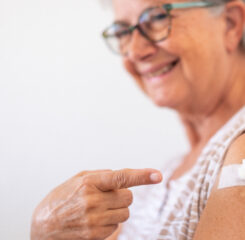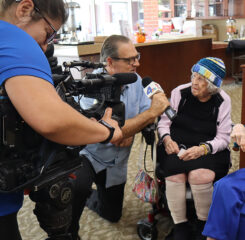CAST Releases New Guide on Resident Tech Support and Training
Given the significant and disproportionate impact of COVID-19 and the social isolation it brought on older adults served by LeadingAge members, LeadingAge CAST has released a new Resident/Client Technology Support and Training Guide.
LeadingAge CAST has seen a significant increase in the deployment of technologies aimed at mitigating COVID-19 impacts, starting with social connectedness and engagement technologies and telehealth. These changes naturally increased the need for providing technology support to residents, not only with resident-facing technology applications that providers offer to their residents, but also with generic technologies older adults commonly use, like smartphones, tablets, computers, etc.
Many providers struggle with providing the tech support residents need. To assist providers, LeadingAge CAST developed the Resident/Client Technology Support and Training Guide. The guide will help providers give residents the connectivity tools that can improve residents’ mental and physical health. The guide includes a white paper, an interactive guide, and four case studies. It is the latest CAST Resource, which helps aging services understand the different support, training, and business models available.
White Paper
The Resident/Client Technology Support and Training white paper explains the different support, training, and business models available for two types of technology:
- Resident/client technology owned by residents/clients and
- Resident-facing or client-facing technology offered by aging services providers.
The white paper covers these and other tips on how to plan for providing technology support and training services.
- Increasing Engagement for Older Adults: A primary benefit of technology training and education is enabling older adults to connect with friends and family through tech tools. This connection reduces social isolation and depression. Tech-savvy older adults can also use and benefit from telemedicine, telehealth, virtual healthcare visits, and remote patient monitoring.
- Calculating Return on Investment: The return on investment (ROI) to aging services providers depends on a number of factors, including the service delivery model, the payment model, the technology, support services, and costs. The white paper shows how to calculate ROI by stakeholder and assess the business case for person-centered care programs that serve older adults with chronic conditions and functional limitations.
- Business Models: The best business model for your organization would be a value-added technology training and support tailored to your residents’ and clients’ needs—a program that they would use and find valuable. One successful approach in the aging field is a train-the-trainer model, with online and physical materials to train field ops.
- Focus Your Team on Human Connection: To find the most-effective trainers, you must identify the best human connectors in your organization. Third-party technology education and training specialists are likely better education partners than your IT staff. Your marketing team may be the best ally for getting residents to adopt the program. Thoroughly vetting all vendors is also highly important.
Case Studies
Four case studies show the outcomes of tech support and training programs among providers that identified the need for this support within their communities.
- Acts’ Resident Technology Amenity Program: Acts Retirement-Life Communities, a LeadingAge CAST Patron, implemented on-site support and a toll-free hotline, which completed 3,235 requests across 10,000 residents in the program’s first full year. Maintenance and security staff are now free from technology requests. Requests for mobile smart device support to stay in contact with family members have surged.
- Creating a Resident Technology Support Service: LeadingAge CAST Patron HumanGood used its own local IT administrators, supported by an offshore helpdesk service and a new service management system, to provide tech support requests and classes. The pilot began in February 2019, and after its first three months, resident satisfaction increased by an average of 3%, and after six months, it rose over 17%. HumanGood has expanded the service to all 18 communities. Although a revamped program, RTSS 2.0, slated for an April 2020 rollout, was postponed due to the pandemic, HumanGood has continued providing help by increasing one-on-one support for residents—particularly with hundreds of requests for assistance in downloading Zoom and telemedicine apps.
- Outsourcing Resident Technology Support and Training During COVID-19: Vi at La Jolla Village contracted with Candoo Tech to offer a 90-day pilot program of virtual tech support. After the 2020 pilot, 89% of residents said they would refer Candoo to a friend, and 90% rated their satisfaction overall as excellent.
- Supporting Residents’ Technology through In-House Support Program – Cypress Cove, of LeadingAge CAST Patron Cypress Living, developed an in-house program that provides resident tech support and incorporates several audio-visual related service functions. Technology use has increased from 40 residents to well over 200 in five years. The program offsets approximately half of the cost of its personnel through resident tech support billing.
Explore the Resident/Client Technology Support and Training Guide.

Most Recommended
November 08, 2024
 HOTMA: New Rules for Housing
HOTMA: New Rules for Housing
November 06, 2024
 Colleagues on the Move, November 6, 2024
Colleagues on the Move, November 6, 2024
November 06, 2024
 Analysis: What Does the Final CY2025 Home Health Rule Include?
Analysis: What Does the Final CY2025 Home Health Rule Include?
October 29, 2024
Katie Smith Sloan Urges Members to Build a Movement, Take Action
Recently Added
December 12, 2024
HUD Releases 2025 Operating Cost Adjustment Factors
December 10, 2024



